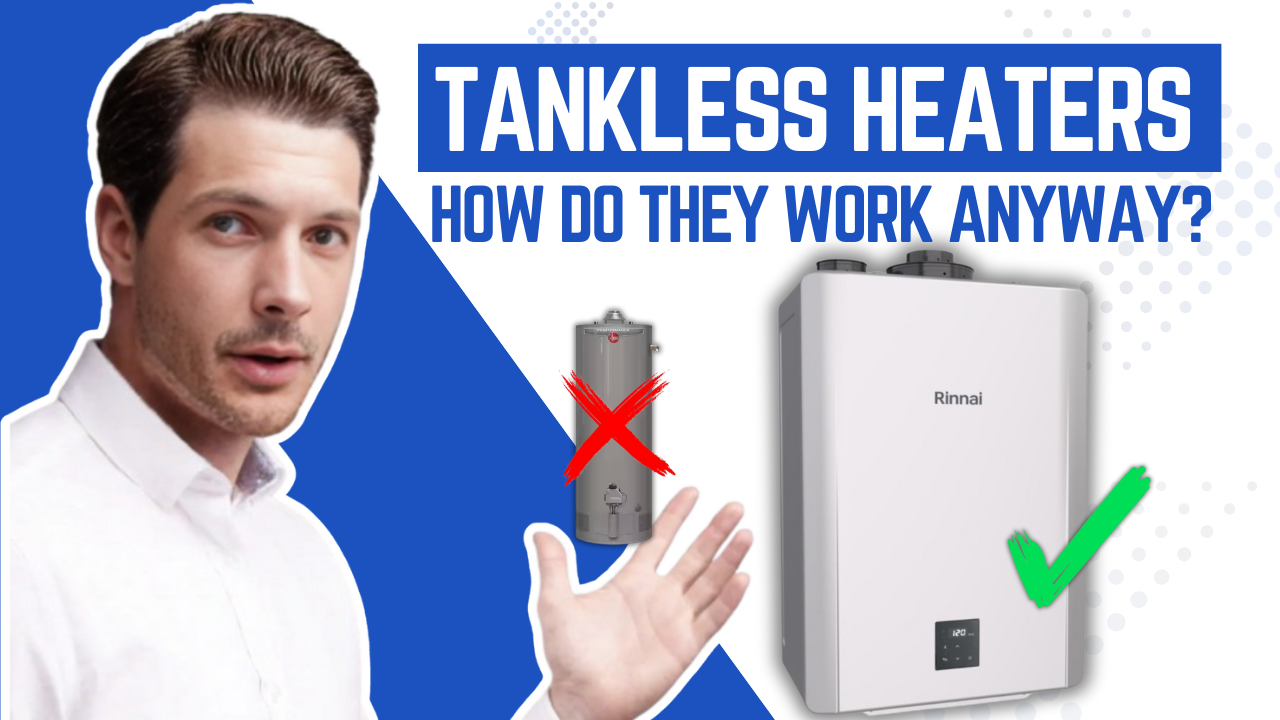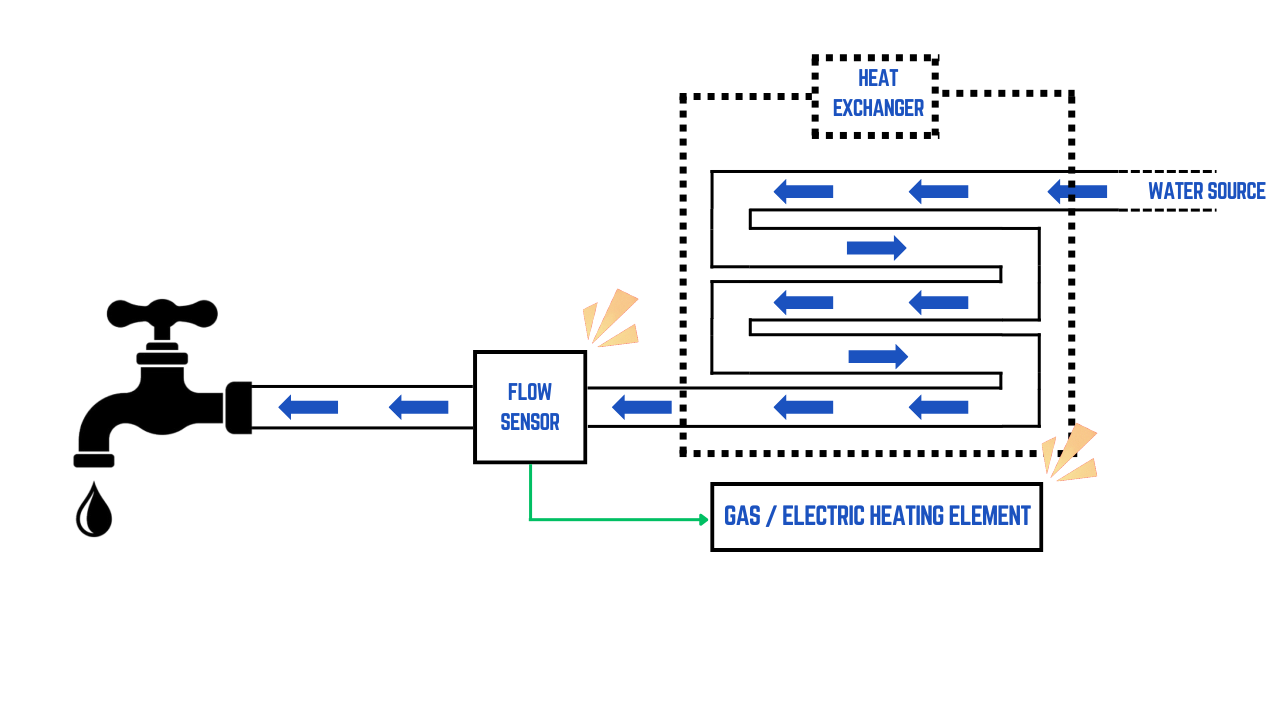
Hey there Adam here again! As someone who’s been in the tankless water heater game for a while, I get it: making the switch can feel like a big decision. Whether you’re dealing with an aging traditional water heater, looking to save space, or just curious about how a tankless system works, you’re in the right place. I’ll walk you through the basics of how does a tankless water heater work, and help you decide if it’s the right option for you.
How does a Tankless Water Heaters Work: Step-by-Step
Tankless water heaters are a major departure from the traditional ones, so understanding their operation is key to deciding if they’re the right fit. Here’s how they work, broken down into simple steps:
1. Water Flow Detection

The process starts when you turn on the hot water faucet in your home. Inside the heater, a flow sensor detects the demand for hot water. As soon as the flow of water is detected, the system jumps into action. This sensor is a key part of the system, ensuring that water only gets heated when needed and that there’s no unnecessary energy use.
2. Heating the Water on Demand

Once the water flows into the tankless unit, the next step is where it really differs from a traditional heater. Tankless systems use either gas burners or electric elements to rapidly heat the water as it passes through. There’s no large tank of pre-heated water sitting around – the water gets heated immediately, making sure you only use the energy you need.
3. Reaching the Desired Temperature

As the water flows through the system, it passes through a heat exchanger, which is the part of the unit that transfers the heat to the water. Once it hits the pre-set temperature, it exits the system and flows to your faucet or shower, hot and ready to go.
5. Continuous Flow

Because tankless heaters don’t store water, they can supply hot water continuously, as long as the system is properly sized for your needs. This means you’re less likely to run out of hot water during a shower or while doing dishes. However, if multiple fixtures are running simultaneously, like your shower and washing machine, the flow rate might drop.
Descaling Your Tankless Water Heaters
One of the main maintenance tasks for tankless water heaters is descaling. Descaling is important to keep your unit running efficiently, especially if you have hard water in your area. Here’s a simple breakdown:
What is Descaling?
Descaling is the process of removing mineral buildup – primarily calcium and magnesium – that can accumulate inside the unit over time. If you don’t descale regularly, it can lead to reduced efficiency, or worse, system failure.

How to Descale?
Descaling is relatively simple, and you can either do it yourself or hire a professional. If you’re going the DIY route, here’s what you typically do:
1.Turn off the power or gas supply to the unit.
2.Close the water supply to the heater.
3.Attach a pump to circulate a descaling solution (typically a mixture of vinegar and water) through the system.
4.Let the solution run through for 45 minutes to an hour.
5.Drain the solution, flush the system with fresh water, and reassemble everything.
How often should you descale? It depends on your water quality and usage, but a general rule of thumb is once every 6 months to a year. You’ll notice that doing this keeps the system running at peak efficiency. Here’s the clearest tankless heater descaling article I can find.
Is a Tankless Water Heater the Right Choice for You?
Now that you have a solid understanding of how does a tankless water heaters work, it’s time to ask the big question: should you make the switch from your current system? Here are a few things to consider.
When It Makes Sense to Switch
Space Saving: If you’re short on space, tankless heaters are a great option. Without a bulky storage tank, you can free up space in your utility closet or basement. Many people install tankless units in smaller spaces like closets or even outside.
Endless Hot Water: If you often run out of hot water in the middle of a shower, a tankless unit solves that problem. The system heats water on demand, meaning you never have to worry about running out of hot water again.
Energy Efficiency: Tankless heaters are generally more energy-efficient than traditional ones because they only heat water when it’s needed. Over time, this can lead to savings on your energy bill.
When It Might Not Be Right for You
Initial Cost: Tankless water heaters tend to have a higher upfront cost compared to traditional systems. They can also require more complex installation, especially if you need to upgrade gas lines or electrical systems.
High Flow Demands: If you have a large family and often have multiple hot water outlets running at the same time, a single tankless heater might not be enough. You may need to install multiple units, which increases both cost and complexity.
Water Quality: If your area has very hard water, descaling becomes even more important. Without regular maintenance, a tankless unit could develop mineral buildup quickly, which could impact its performance.
Need More Help Deciding?
I’ve reviewed a bunch of tankless water heaters in the past, and I’m happy to recommend a few if you’re ready to dive deeper into your options. If you’re looking to replace your old tank heater, here’s my guide on choosing the best tankless alternative. Whether you’re looking for something compact, energy-efficient, or with a high flow rate for big homes, I’ve got you covered.
So, how does a tankless water heater work? In short, it heats water on demand, saving space and energy, and providing endless hot water. But, it’s not always the right choice for everyone, so be sure to weigh your options carefully before making the switch.
Hey, I’m Adam Miller. After years of crawling through cramped basements fixing water heaters (and discovering some pretty questionable DIY attempts), I figured it was time to share what I’ve learned in a way that doesn’t involve me getting covered in dust. I started this site to help you make sense of the whole tankless water heater thing—whether you’re tired of cold showers or just want to save a few bucks on your energy bill. I like to keep things simple, practical, and if I can throw in a bad joke or two along the way, even better!